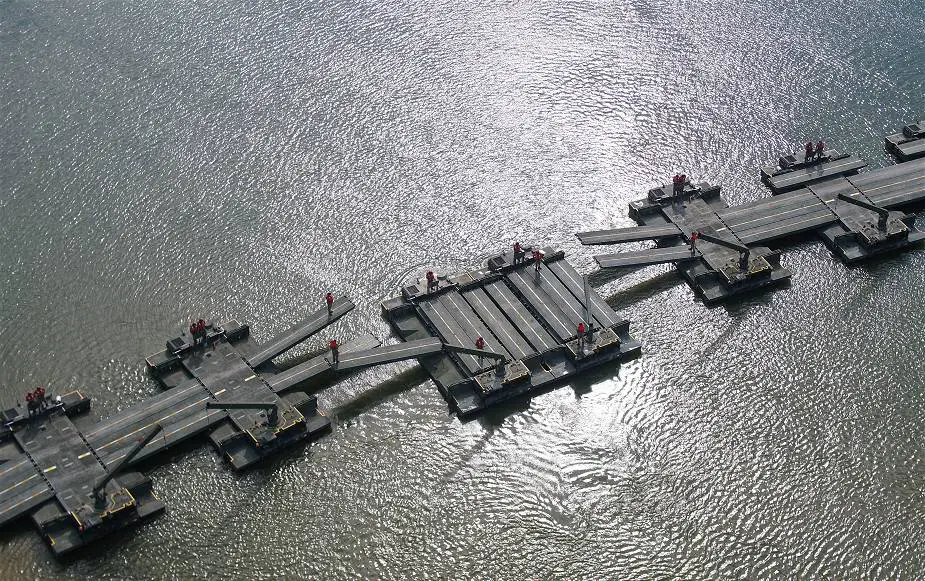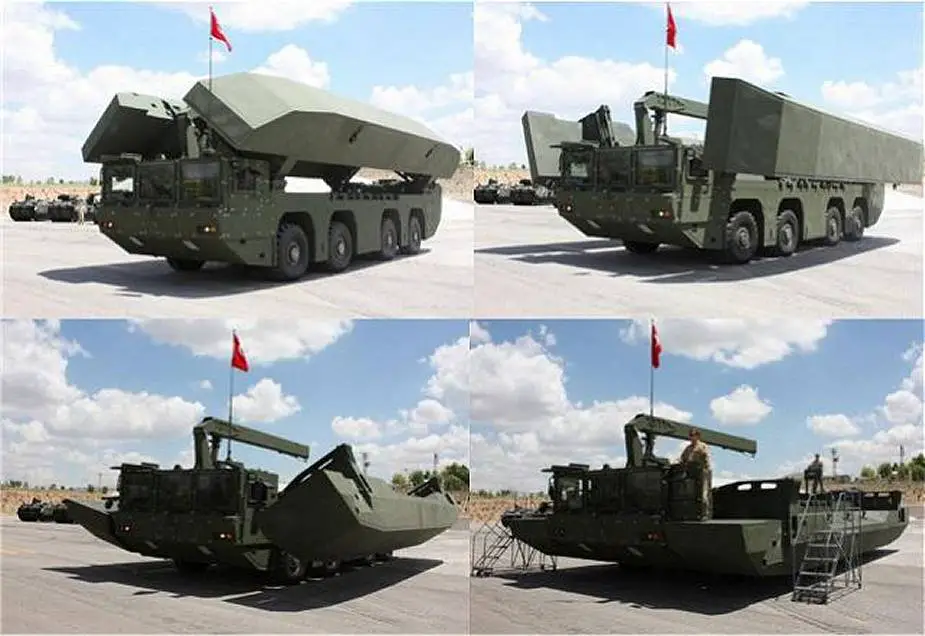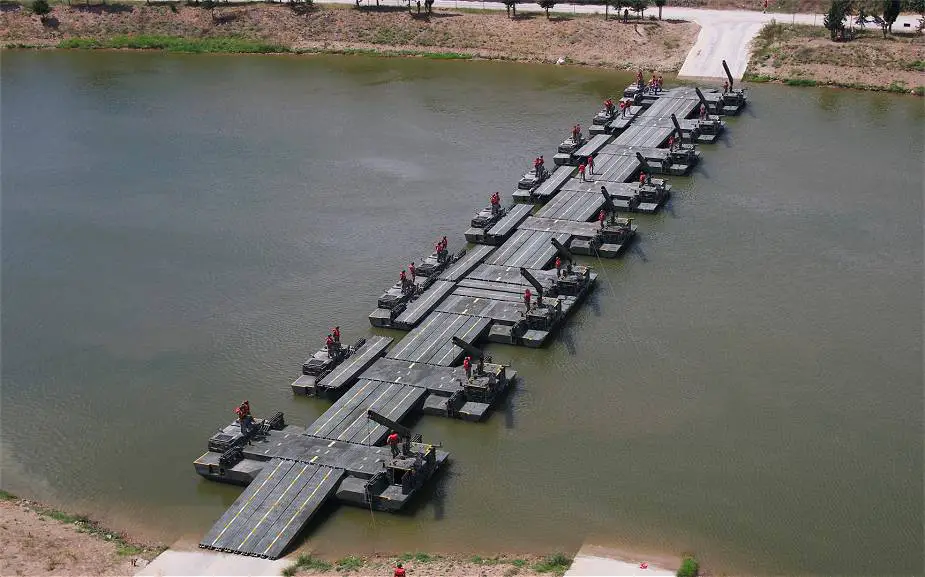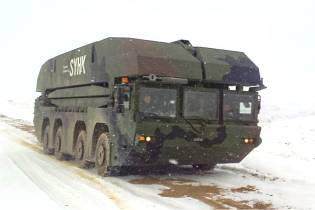- Army
- Air Defense Systems
- Anti-tank systems and vehicles
- Armored Vehicles
- Armoured personnel carriers
- Artillery Vehicles and Weapons
- Command Post
- Communication Vehicles and Systems
- Electronic Warfare
- Engineer | Maintenance Vehicles
- Infantry Fighting Vehicles
- Main Battle Tanks
- Missiles
- Tactical and Logistic Vehicles
- Radars
- Unmanned Systems
- Weapons
- Navy
- Air
OTTER FNSS
OTTER FNSS
Armored Amphibious Assault Bridge AAAB and Ferry System based on 8x8 chassis - Turkey

Description
The OTTER Rapid Deployable Amphibious Wet Gap Crossing System is an amphibious bridge and ferry system designed for rapid and safe wide-wet gap crossing operations. With its diesel engine, automatic transmission, pneumatic suspension and hydraulic brake system, the OTTER can climb up to 60% gradient and move on 30% side slopes. The features of the OTTER when compared with similar systems are; 8x8 drive system with all-wheel steering, 4ea ramp carrying capacity, ballistic protected crew cabin, and positive pressure NBC protection system. The vehicle also has front and rear cameras to enhance situational awareness and an adjustable ride height control suspension system which provides better maneuverability in cross country.
A single OTTER system in the ferry role can transport an MLC 21 tracked vehicle. MLC 85 T vehicles can be transported by combining 2 OTTER systems from their pontoons. MLC 120 W vehicles can be transported on rivers and lakes by coupling three OTTERs.
A 150 m bridge that enables MLC 120 W and MLC 85 T vehicles to cross rivers can be formed by combining 12 OTTERs. For specific missions, numerous OTTERs can be coupled together to cross wider distances. OTTER system is also fitted with a self-recovery winch, automatic fire suppression system, emergency anchor, and easy fault detection with CAN-BUS system.
OTTER FNSS variants:
- No variants at this time.
Technical Data
| Design and Protection |
|
The FNSS OTTER or AAAB Armoured Amphibious Assault Bridge is operated by a crew of three. A crew cabin is available at the front of the vehicle. The hull and crew cabin are made of welded aluminum. The crew cabin provides protection against the firing of small arms and artillery shell splinters. When traveling the side elements of the bridge are on top of the vehicle and are swung through 180 degrees to either side when deployed with the other elements being fitted using the onboard crane.
|
 |
| When traveling the side elements of the bridge are on top of the vehicle and are swung through 180 degrees to either side when deployed with the other elements being fitted using the onboard crane. |
| Mobility |
|
For its displacement in road conditions, the FNSS OTTER is designed using an 8x8 chassis based on the PARS 8x8 armored vehicle personnel carrier. The vehicle is motorized with a German Deutz turbocharged diesel engine, developing 522 hp, coupled to a fully automatic transmission with six forward and one reverse gears, and a two speed transfer case. The OTTER can reach a maximum road speed of 76 km/h with a maximum road range of 600 km. With its diesel engine, automatic transmission, pneumatic suspension and hydraulic brake system, the OTTER system can climb up to 50% gradient, move on a 30% side slope and cross a trench of 2m maximum. The OTTER system has two water pump jets that provide the water operations and 360° movements in the water. The system can operate in water currents up to 2.5m/s (10km/h).
|
| Accessories |
| The FNSS OTTER, different from similar systems in the market, has an 8x8 drive system with a central tire inflation system. For the safety issues, the OTTER system has a self-recovery winch, an automatic fire suppression system, a fixed fire extinguishing system, portable fire extinguishers, and positive pressure NBC system. The standard equipment of the FNSS OTTER includes also Anti-lock Braking System (ABS), Traction Control (CT), land and emergency anchoring systems, radio intercom systems, onboard diagnostics system, and automatic bilge pumps with manual override. |
| Accessories |
| As a ferry, the FNSS OTTER system can transport MLC 21 tracked vehicles. By deploying the ramps, which are carried by a hydraulic crane, and joining two systems, the MLC70 T vehicle can be transported. In the road position, the crane is on the centerline of the vehicle. Two OTTER systems can be coupled together to form a pontoon bridge and can transport an MLC85 T vehicle. By coupling three systems ramp to ramp, up to MLC120 W vehicle can be transported over a wet gaps. Eight OTTER systems can be combined together ramp to ramp to construct a 100 m long bridge in around 10 minutes that is capable of carrying MLC85 T & MLC120 W vehicles. For specific missions, numerous OTTERs can be coupled together to cross wider distances. |
 |
| As a ferry, the FNSS OTTER system can transport MLC 21 tracked vehicles |
 |
| As well as the role as a ferry, 8 OTTER systems can be coupled and constructed as a 100m long bridge for the crossing of vehicles up to MLC100 W. |
Specifications
| Type | Engine |
| Armoured Amphibious Assault Bridge and Ferry System | 522 Hp (390 Kw) Diesel Fully Automatic |
| Ground Clearance | Transmission |
| 0 to 65 cm (adjustable) | 6 forward and 1 reverse |
| Number of axles | Vehicle Weight |
| 4 | 36,500 kg |
| Fuel Capacity | Vehicle Speed |
| 400 liters | 50 km/h maximum road speed |
| Crew | Water Speed |
| 3 | 10 km/h |
| Electrical System | Dimensions |
| 2x12V, 120 Ah batteries | Length: 13,0 m; Width: 3,5 m; Height: 4,1 m |
| Suspension | Vehicle Range |
| Double Wishbone, Independent, Air Suspension | 600 km |
| Tire Type | Payload |
| Heavy Duty 16.00 R20 with Run Flat | - 2 bay ferry payload: MLC 70 (Tracked) - 3 bay ferry payload: MLC 100 (Wheeled) - Bridge payload: MLC 70 Tracked & MLC 100 Wheeled |
| Axles | Length of Bridge |
| Differentials with lock and geared wheel hubs | 150 m with 10 AAAB vehicles |
| Turning Radius | Side Slope |
| 12 m (centerline) | 30% |
| Trench Crossing | Gradient |
| 2 m | 60% |
Details View
 |
|
 |
 |
 |
 |
Pictures - Video



























